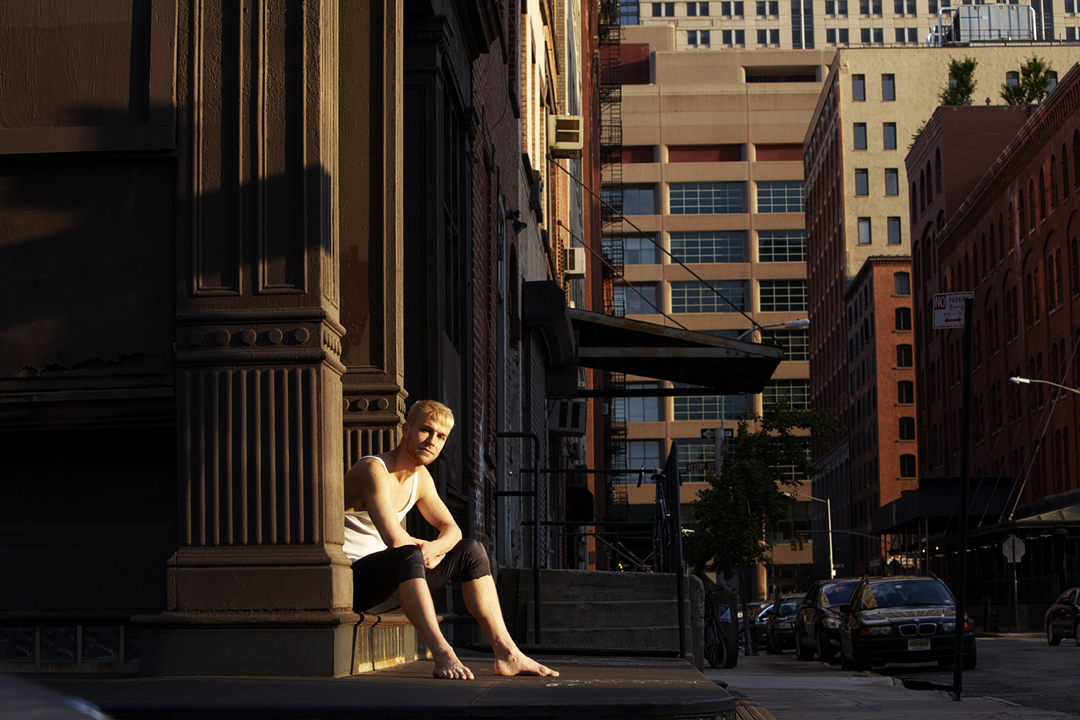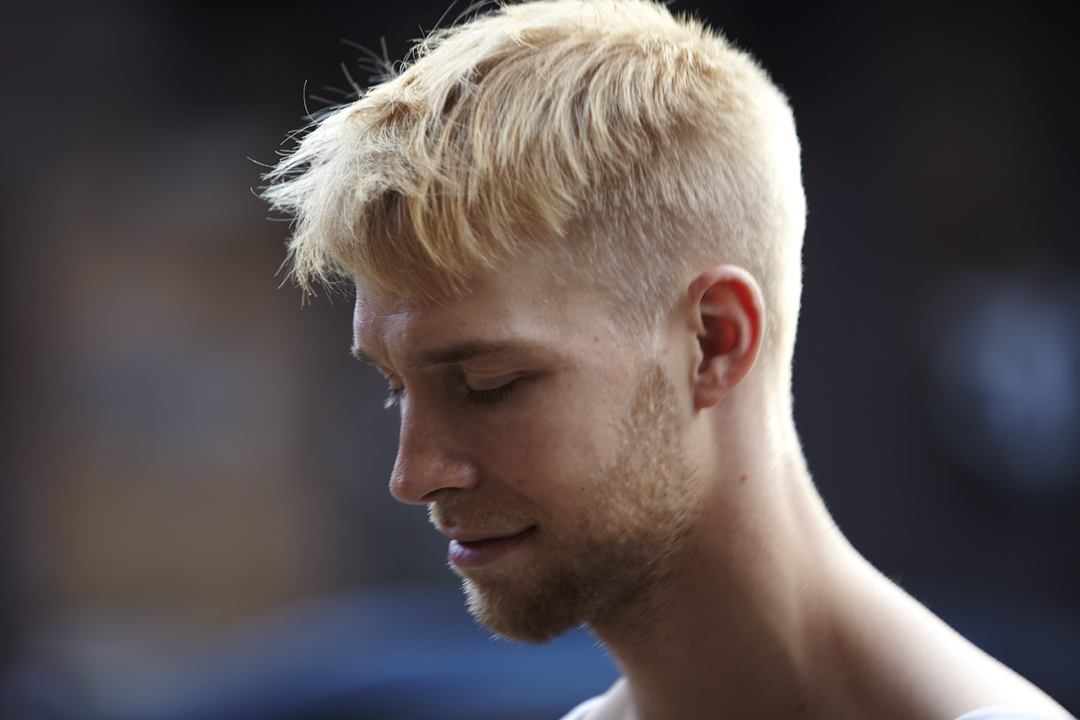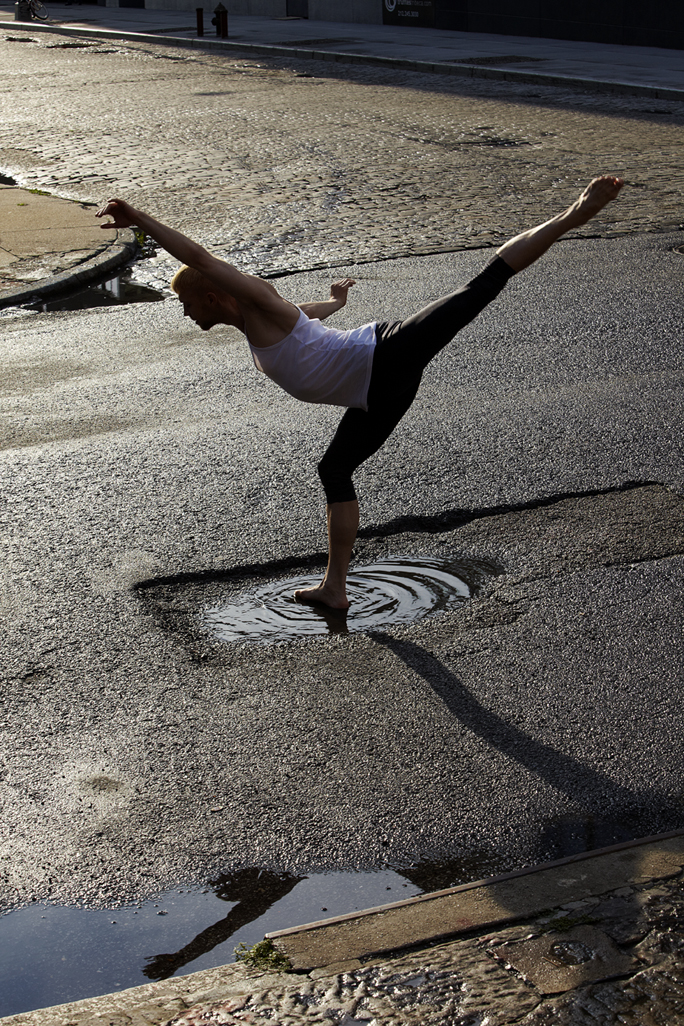The answer to the question
Human encounters, longings and memories, all shown through slow lingering movements and all beautifully executed to the accompaniment of a soft drizzle. That’s one way to sum up “The Rain,” a new and exciting dance film that has gathered critical acclaim internationally. Nordic Reach caught up with the man behind the film, Swedish dancer and choreographer Pontus Lidberg.
-
 Pontus Lidberg photographed on the lower East side, Manhattan by Kristoffer Dan-Bergman.
Pontus Lidberg photographed on the lower East side, Manhattan by Kristoffer Dan-Bergman. -
-
Like most dancers, Pontus Lidberg seems to defy age. Lithe, beautiful and straight as a ruler, with blond hair and the bluest of eyes, he looks like a young boy barely out of high school.
“I’m older than I look, actually. And age catches up with dancers eventually,” he says smiling carelessly. Because, like most dancers, Lidberg lives in the here and now — who cares about tomorrow and old age?
Lidberg is in New York partly because he is showing his film “The Rain,” but more importantly, perhaps, because he has begun collaborating with David Lang, a New York-based composer whose music caught Lidberg’s attention some years ago. The pair is currently at work on a project Lidberg calls “Labyrinth Within,” a new dance film which will explore the relationship between façade and content, and the need for human beings to be themselves in order to meet others.
“Letting go of all outer constructions in order to have an encounter with another human being,” Lidberg explains.
Film, he continues, seemed natural for him as a choreographer and he did his first film in 2003.
“With film, if you have a good budget, you can really achieve exactly what you want. The physical expression can be refined in a way in which it can’t on stage. On the other hand, with film comes a huge machinery, you have to find money … it’s a lot of work.”
Lidberg got his career in motion at age 4 when he was put into a combined play and ballet class (where he complained there was too much play and not enough dance).
“I knew then already that I wanted to dance,” he says. “And although today I can sometimes feel that classic ballet is a bit restricted, it’s a good platform to have.”
He says he always thought he just wanted to become a dancer, but once he became one — at age 19 — he realized it wasn’t, as he puts it, “the answer to the question.”
“Very often a dancer is the instrument for other people’s ideas and choreography. But I had my own ideas, and Operan (the Royal Opera in Stockholm, where he was then engaged) encouraged me.”
And so he began to choreograph. His first piece, “Les Désespérés” to music by Jacques Brel, was made eleven years ago and spurred him to continue. He was soon able to show his works at different venues. He has since worked with the Vietnam National Ballet and the Wheeldon Company, as well as Norrdans. In 2008 he was artist-in-residence at the Headlands Center for the Arts in San Francisco, and he is right now busy choreographing for himself and fellow dancer Gabrielle Lamb for an upcoming gala at the Vanemuine Theatre in Tartu, Estonia. The latter will feature an evening of Vaslav Nijinsky, with dances associated with the famous Russian God of Dance: “Afternoon of a Faun” and “Petrushka.”
“I tend to work with the same major themes over and over,” Lidberg explains. “Relationships, meetings between people, a sense of belonging … or not. I get ideas quite often, which is fortunate because I don’t think you can force an idea: You either have it or you don’t. Then music can help manifest that idea into something tangible. Right now I am listening to a lot of Vivaldi, for example. I also like to read and see movies, but never TV. I think TV is a complete waste of time.”
Choreographing dance is a curious art form that relies less on notation than most of us might think.
“Sometimes something wonderful happens in the studio when you practice. It’s like a flow, it’s perfect, but recreating can be very difficult,” Lidberg says. “It’s a bit like writing on water. I don’t care what technique my dancers have. To me experience and willingness to do just about anything is much more important. They must be versatile that way. Theoretically I am not against anything, if somehow the right expression can be gained.”
As for remaining a dancer himself, he says he is completely shaped by his training in classic ballet, and that not taking the traditional morning class is not even an option.
“It’s something I will do for the rest of my life, whether I dance or not.” -
 He says he always thought he just wanted to become a dancer, but once he became one — at age 19 — he realized it wasn’t, as he puts it, “the answer to the question.” Pontus Lidberg photographed by Kristoffer Dan-Bergman
He says he always thought he just wanted to become a dancer, but once he became one — at age 19 — he realized it wasn’t, as he puts it, “the answer to the question.” Pontus Lidberg photographed by Kristoffer Dan-Bergman -
-
Written by Eva Stenskär
Photographed by Kristoffer Dan-Bergman -
 Pontus Lidberg photographed by Kristoffer Dan-Bergman
Pontus Lidberg photographed by Kristoffer Dan-Bergman -
For more information: www.lidberg.se
-
-
